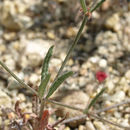Comments
provided by eFloras
The name
Eriogonum angulosum has been applied to all of the members of its species complex except
E. gossypinum. Since the 1950s, the name consistently has been applied to plants with long, exserted stamens and strongly angled stems of the Inner Coast Ranges (Alameda and Contra Costa counties south), the western foothills of the southern Sierra Nevada (Tulare County south), and the Central Valley (San Joaquin County south). The southern edge of the range is the northern foothills of the Transverse Ranges (Ventura and Los Angeles counties). The species can be common and occasionally abundant but rarely is weedy. A mixed collection (with
E. gracillimum) from Barstow, San Bernardino County (
K. Brandegee s.n., May 1913, UC), and two sheets of the species from San Diego gathered by Susan Stokes apparently in 1895 (B, SD) are discounted as to location.
In late fruit, the bractlets at the base of the pedicel inside the involucres of Eriogonum angulosum often elongate and broaden into oblanceolate segments that fill the involucre. As a result, the involucre appears to have several rows of teeth. This feature may be seen also in E. viridescens, but typically the involucres there appear to have only two or three rows of teeth. This feature is seen rarely in E. maculatum.
- license
- cc-by-nc-sa-3.0
- copyright
- Missouri Botanical Garden, 4344 Shaw Boulevard, St. Louis, MO, 63110 USA
Description
provided by eFloras
Herbs, erect to spreading, annual, 1-5(-10) dm, tomen-tose to floccose or glabrous, usually grayish. Stems: caudex absent; aerial flowering stems erect, striated, angled, solid, not fistulose, 0.5-1 dm, to-mentose to floccose. Leaves basal and cauline; basal: petiole 0.5-3 cm, mostly floccose, blade oblanceolate to oblong-lanceolate, 1-4(-4.5) × (0.2-)0.5-1(-1.3) cm, tomentose abaxially, floccose or glabrate and grayish or greenish adaxially, margins crenulate; cauline sessile, blade lanceolate to oblong, 0.5-2 × 0.3-0.8 cm, similar to basal blade. Inflorescences cymose, open, 5-80 × 10-60 cm; branches striated, angled, sparsely tomentose to glabrate; bracts 3, scalelike, 1-3 × 1-3 mm. Peduncles erect, straight, slender, 1-2 cm, sparsely tomentose to glabrous. Involucres turbinate-campanulate to campanulate, 1.5-2.5(-3) × 1.5-2.5(-3), sparsely puberulent; teeth 5, erect, 0.3-0.6 mm. Flowers 1.5-1.8 mm; perianth white to rose, without a conspicuous rose-purple spot on each outer tepal, minutely glandular-puberulent; tepals dimorphic, those of outer whorl elliptic to obovate, sometimes inflated proximally, those of inner whorl narrowly spatulate; stamens exserted, 2-3 mm; filaments pilose proximally. Achenes light brown to brown, 3-gonous, 1-1.5 mm, glabrous.
- license
- cc-by-nc-sa-3.0
- copyright
- Missouri Botanical Garden, 4344 Shaw Boulevard, St. Louis, MO, 63110 USA
Habitat
provided by eFloras
Clayey flats and slopes, mixed grassland, saltbush, and chaparral communities, oak and conifer woodlands; 0-800m.
- license
- cc-by-nc-sa-3.0
- copyright
- Missouri Botanical Garden, 4344 Shaw Boulevard, St. Louis, MO, 63110 USA
Eriogonum angulosum: Brief Summary
provided by wikipedia EN
Eriogonum angulosum is a species of wild buckwheat known by the common name anglestem buckwheat.
The plant is endemic to central and Southern California, where it is common to abundant in many types of habitat, from chaparral and oak woodlands to sagebrush and the Mojave Desert sands.
- license
- cc-by-sa-3.0
- copyright
- Wikipedia authors and editors

